- With a $6.3 billion purchase, it becomes the largest producer in the Denver-Julesburg basin.
According to Bloomberg article published on May 23, 2023, even after being outbid for Anadarko Petroleum Corp. in 2019, Chevron Corp. has expanded its position in the US shale industry beyond the giant Permian basin— probably at a lower cost than it would have paid for Anadarko.
First, it was the $5 billion deal in 2020 to acquire Noble Energy Inc.; second, on Monday, it announced a $6.3 billion deal to buy PDC Energy Inc. Together, the two relatively small all-stock deals will transform Chevron into the largest oil and gas producer in the so-called Denver-Julesburg shale basin, which spreads across Colorado, Nebraska and Wyoming.
In Chevron-speak, the DJ basin ads “another piston” to its already strong shale engine.
The location may surprise, because Colorado tends to fall under the radar of Wall Street, and the state is seen as more risky from a regulatory point of view than Texas or even New Mexico. Dig deeper, however, and the scale of the new business is evident. Almost out of the blue, the DJ basin will become one of Chevron’s top-five assets in terms of production and free cash flow. If the deal closes by year end, as expected, Chevron would pump about 360,000 barrels of oil equivalent a day there, quickly approaching 400,000 barrels a day by 2024. In its much better-known Permian location, it’s pumping about 800,000 barrels a day.
On the surface, the deal may look more opportunistic than strategic. Certainly, Chevron appears to have taken advantage of the fact that any oil company heavily exposed to Colorado tends to trade at a discount due to investor worries about environmental regulatory risk. PDC wasn’t an exception, and Chevron has bought oil and gas reserves relatively cheap, paying about $7-a-barrel for the inventory. The company expects the transactions to be accretive to its shareholders immediately, adding about $1 billion to its annual free cash flow, a number that may go up as the synergies could be significantly larger than what Chevron indicated. From a business perspective, the question isn’t why Chevron is buying, but why PDC is selling.
Yet, there’s a strategic angle to it too. The purchase speaks volumes about the geographical and business shift ongoing in the US shale industry. Of the five major American shale basins, two – where the revolution largely originated — are already past their prime: production in the Bakken, in North Dakota, and the Eagle Ford, in southern Texas, has peaked. Another basin, the Anadarko-Woodford in Oklahoma, has probably peaked too. The oil game today is all about the Permian and the DJ basins. In both, Chevron is now one of the top producers.
In expanding beyond the Permian into a second US shale basin, Chevron is becoming even more American, quickly reversing its internationalization following the merger with Texaco about two decades ago, when it created mighty business units in far flung locations like Australia and Kazakhstan. By next year, about 40% of the company’s operating cash flow would come from pumping oil and gas from onshore and offshore fields in America, according to Citigroup Inc. Add the US refining and marketing business to that, and roughly half of Chevron’s operating cash flow will be Made in the USA.


